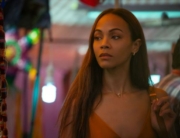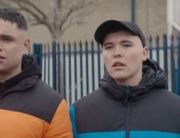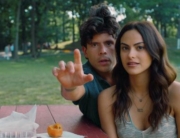One glaring departure between this shiny and innocuous new sequel and the original blockbuster Mary Poppins (1964) is that it’s doubtful the latter’s producer, Walt Disney, would have signed off on a labor union organizer as a likeable character, given his fraught history with unions during the early 1940s when his studio’s animators went on strike. That said, he would recognize the tone of director Rob Marshall’s faithful-in-spirit take on the beloved British nanny.
Baby boomers who have fond memories of the Julie Andrews film can rest assured that Mary Poppins has successfully transitioned into the 21st century with her head held high, mainly because the follow-up is refreshingly retro. It’s unabashedly a family musical that would have been at home in the 1960s before Broadway-style musicals rapidly fell out of fashion toward 1970. (But how on Earth did it earn its strange PG rating?)
It’s as though the filmmakers of Mary Poppins Returns have stepped back in time—54 years to be exact—to continue the adventures of the firm and fantastical British nanny. They use much of the original’s color scheme and production design as a template, and even the title sequence mirrors the artwork of the ’60s. The new score by Marc Shaiman and Scott Wittman, meanwhile, takes its cues from the original songs written by the brothers Richard M. and Robert B. Sherman. (The Shermans, in turn, were influenced by early 20th-century music hall ditties, setting them to big, splashy Broadway orchestration).
But instead of the London of the Edwardian era, the titular character now sweeps down from the sky and lands back on the Cherry Tree Lane of the 1930s, in order to take charge of the three children of her former ward Michael (Ben Whishaw). Now grown-up, widowed, and world weary, he’s afraid that the family manse will be foreclosed and he and his brood will be out on the street. (His sister, Jane, played by Emily Mortimer, is the leftist activist.) This time around, the working-class bloke who serves as Mary’s constant companion is Jack (Lin-Manuel Miranda), a lamplighter, who along with all of his mates are the happiest working-class labor force in the city, high-kicking to “Trip the Light Fantastic,” which is either a knock-off of or a tribute to—depending on how you look at it—the Shermans’ “Step in Time.”
The fidelity to the first film is equally apparent in the hand-drawn animated sequences, which similar to the original, have a pastel palette and blend in live action. And one detail everyone can agree on is that the green-screened special effects are now seamless and less obvious, as the actors really do look enveloped in an underwater world or 18th-century countryside. Still, in both movies the musical numbers can go on just a tad too long. Mary Poppins certainly followed the pacing of its time, while the new film feels faster thanks to more edits within any given scene.
However, one element missing in 2018 is a counterpart to 1964’s Bird Woman, a character played by Jane Darwell, who begs for money on the steps of St. Paul. Though the new version is set during the mid-’30s, aka the Great Slump, there are no signs of either desperation or misery or a catastrophe looming on the horizon. Shaiman and Wittman’s score is incessantly cheerful, with nary a song in the melancholic register of the Shermans’ “Feed the Birds.”
Despite some departures, the filmmakers haven’t really made the material, based on the stories by P.L. Travers, their own. There are no deviations from the blueprint of 1964, so no one is going to leave feeling their memories are challenged. Julie Andrews sang a considerably better score—she was an actual singer, of course—with a script that was darker. The 2018 selections, catchy here and there, have nowhere near the variety of tempo, pizzazz, or melody to match the Shermans’ showmanship. Their “Chim Chim Cher-ee,” “Stay Awake,” “Jolly Holiday,” among others, stood out on their own, while many of the new tunes blur together and come across as filler. When Mary Poppins was nominated for 13 Academy Awards, it was during an era when only one song could receive a nomination per film. “Chim Chim Cher-ee” won, but if the rules had been looser, most likely others would have been singled out as well. The soundtrack went on to become one of the biggest selling albums of the 1960s.
As Mary Poppins, Emily Blunt tackles the part with relish, though perhaps with more haughtiness and flirtatious glances than Andrews, yet it would be impossible to say where Andrews’s performance ends and Blunt’s begins, or if both interpretations are so much alike because the role first sprung from Travers’s pen. (Visually, the two actresses could pass as sisters.) Yet with so many episodes and eccentricities popping up onscreen, including Meryl Streep’s hammy turn as Cousin Topsy, one could forget midway that Mary Poppins is central to the story line.
As a result, Miranda steals the film. As Mary Poppins would say, he’s “practically perfect in every way,” appearing in nearly every production number and with almost the same amount of screen time as anyone else. Crucially, he’s the only cast member who brings the pizzazz of a Broadway musical performer. Here, Miranda is much more playful and a sly ladies’ man than he was on stage as Alexander Hamilton in Hamilton—and his Cockney accent is convincing, too.







Leave A Comment